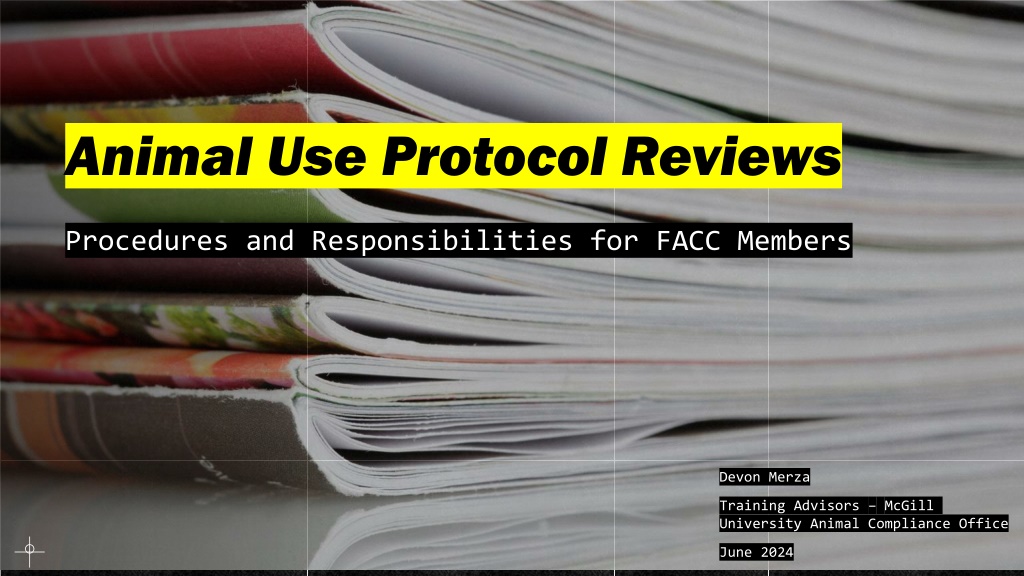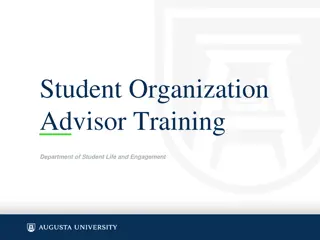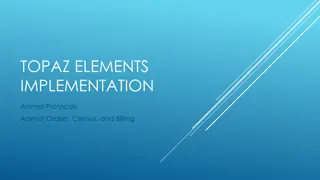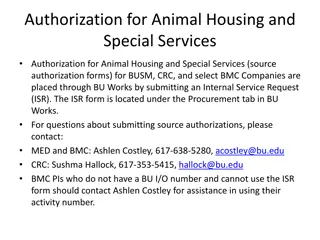Animal Use Protocol Reviews and Responsibilities: Guidelines for FACC Members and Training Advisors
This document outlines the protocol review procedures and responsibilities for FACC members and training advisors at McGill University's Animal Compliance Office. It emphasizes the importance of scientific or pedagogical merit, alignment with guidelines and frameworks, and justification for deviations. Specific sections address general review information, species and animal numbers, categories of invasiveness, and the scientific and pedagogical merit of animal use. Relevant policies and maximum validity periods are also provided.
Download Presentation

Please find below an Image/Link to download the presentation.
The content on the website is provided AS IS for your information and personal use only. It may not be sold, licensed, or shared on other websites without obtaining consent from the author. Download presentation by click this link. If you encounter any issues during the download, it is possible that the publisher has removed the file from their server.
E N D
Presentation Transcript
Animal Use Protocol Reviews Procedures and Responsibilities for FACC Members Devon Merza Training Advisors McGill University Animal Compliance Office June 2024
General Review Information Must have Scientific or Pedagogical Merit Align with CCAC Guidelines/Regulatory Frameworks/University Standard Operating Procedures + Deviations must be SCIENTIFICALLYJUSTIFIED Limited technical jargon Amendments and Annual Reviews
General Information Section Keywords +Procedures +Wildlife Studies must be identified Description, Objectives and Goals +Limited technical jargon
Scientific and Pedagogical Merit Use of animals must have Scientific or Pedagogical Merit + 2 reviewers with qualified expertise without conflict of interest Pedagogical: Participant Feedback is important! + Administrative Responsibility: Scientific: Funding Agency(ies) or Faculty Pedagogical: Animal Compliance Office (ACO) + Maximum Validity: Scientific: 5 years Pedagogical: 4 years + See APWOC Policy on Peer Review for Scientific Merit (2023) + See APWOC Pedagogical Merit Review Policy for Teaching and Training Protocols Using Live Animals (2021)
Species and animal numbers Justification for the use of species + Non-animal modules/low sentience + Evidence must be provided + A simple statement that there is no replacement alternative is insufficient Characteristics Animal Numbers
Categories of Invasiveness A: Experiments on most invertebrates or on live isolates + Tissue cultures + Single-celled organisms + Wildlife: Observational with no disturbance B: Experiments which cause little or no discomfort or stress + Natural food and/or water deprivation Experimental Wildlife Short-term restraint Observational with some disturbance but no modifications to behaviour Blood collection/injections Non-survival studies For wildlife studies replace experiments in category titles with methods .
Categories of Invasiveness C: Experiments which cause minor stress or pain of short duration + Short periods of food and/or water deprivation which exceed nature + Procedure should not result in distress Experimental Wildlife Minor surgery Capture and immediate release Short Restraint above category B Short-term restraint Blood collection/injections For wildlife studies replace experiments in category titles with methods .
Categories of Invasiveness D: Experiments which cause moderate to severe distress or discomfort + Major Surgery + Prolonged Restraint + Induction of behavioural stresses + Exposure to noxious stimuli from which escape is impossible + Procedure can cause irreversible disruption of sensorimotor organization but distress is only short-term Wildlife Capture with potential injury Wild animal in captivity* Translocation *Animals in captivity are considered similar to experimental animals if not released immediately after the procedure For wildlife studies replace experiments in category titles with methods .
Categories of Invasiveness E: Procedures which cause severe pain near, at, or above the pain tolerance threshold of unanesthetized conscious animals + Anything in excess of Category D + Procedures causing pain or distress without anesthesia/ analgesia + Substances/procedures with unknown effects + Environmental deprivation + Euthanasia method not approved by the CCAC + Wildlife: Capture methods with a high potential of causing severe injury Animals in captivity under Category D are released immediately after the procedure
Study Segments, Drugs, Procedures, Training Verification Study Segments + Chronological + Intervention Points + Mortality Rates Reportable Animal Welfare Incidents Drugs and Substances Procedures Sections + Linked to Training Verification Section Training Approval + Completion of the online McGill Ethics Exam + Registration confirmation for future training
3Rs Section Replacement + Justification of species Reduction + Justification of animal numbers Analysis Refinement + Information from study sections Changes in procedures Limiting animal use/ length Training and supervision outside core training Extra enrichment
Reviews and Friendly Reminders Comm. Rep. PIs FACC Vet. Student Rep. Facility Staff
Reviews and Friendly Reminders Review Questions + What? + How? + Why? Scope of Review Review as soon as possible, respect deadlines Constructive criticism Please be respectful in your comments Repeat posts
New AUPs and 4-Year Renewals New AUPs must ensure all sections of the AUP are completed. 4-Year Renewals are treated like new AUPs Reviewers: + Full Committee Required Quorum: + Chair + Veterinarian + Community Representative Deadline: + Minimum of 7 days
Minor Amendments Personnel or Funding Information, <20% In Animal Numbers, New Strain, Change in Procedure or Housing Location, Less Invasive or Distressing Procedures Reviewers: + Chair and/or delegate Required Quorum: N/A Deadline: + 5 Business days
Major Amendments A Change In The Fundamental Objective, Species, And/Or Use Of More Invasive Or More Frequent Procedures, Increase Of 20% > In The Number Of Animals Reviewers: + Full Committee Required Quorum: + Chair + Veterinarian + Community Representative Deadline + 5 Business Days
Annual Review Justification for animal use and the 3 R s Number of animals and the categories of invasiveness Endpoints Reviewers: + Full Committee Required Quorum: + Chair + Veterinarian + Community Representative Deadline + 5 Business Days
Quiz There are various times where it is required that researchers need to show their work (References, Literature Searches, Attachments). Out of the following options, which one is not a time when this is required? A.Animal Numbers B.Animal Justification C.Three R s D.Categories of Invasiveness
Quiz A researcher is trying to determine which category of invasiveness to use for their animals. Here are the details: Experimental study using rats Normal housing conditions Non-survival surgery under Anesthesia Iso+CO2 Euthanasia followed by Decapitation Which COI would most likely be appropriate? A. A B. B C. C D. D
References APWOC Policy on the Study and Use of Animals (2022) APWOC Policy on Peer Review for Scientific Merit (2023) APWOC Policy on Pedagogical Merit Review for Teaching and Training Protocols Using Live Animals (2021) CCAC Instructions for Completion of CCAC Annual Use Data From (2023) CCAC Guidelines on Animal Use Protocol Review (1997) CCAC The Animal Care Committee and the Role of Its Members (2021) CCAC Terms of Reference for ACC (2006) McGill University FACC Terms of Reference (2023)
Next Presentations (Tentative) Animal Facilities and Alternative Sites Inspections (July 2024) August no FACCs Endpoints and Animal Welfare Assessments (September 2024) Literature Searches and Reporting for AUPs (October 2024) MAWI? RAWI? It s an Owie: Reporting and Procedures for Animal Welfare Incidents (November 2024)
Questions? Contact us at Animalcare@mcgill.ca























